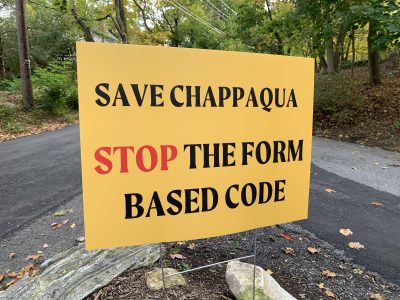New Castle, Chappaqua School Board in Form-Based Code Spat

The Chappaqua Board of Education has hired its own consultant to analyze data on the potential number of students that new downtown development could yield under the Town of New Castle’s proposed form-based code.
Last week school trustees also agreed to ask town officials to slow down its process in reviewing the new code for downtown Chappaqua to give the district’s consultant, The Chazen Companies, adequate time to complete its work.
The Board of Education announced its intentions after questioning how 997 units of new residential units under the proposed code’s maximum buildout scenario would generate a net increase of just 96 schoolchildren.
As fiduciaries of the district, it is the school board’s responsibility to gauge the risks and weigh the impacts on expenses and operations, including a potential need for redistricting, Board President Victoria Tipp said at the trustees’ Oct. 14 meeting.
“For this reason, appropriate input with accurate information on the impact on the school district is a necessary and crucial part of the analysis,” Tipp said in explaining the need for the district to have its own consultant.
In its environmental review process mandated by the state, town officials are required to include a maximum buildout scenario. Throughout public discussion on the form-based code, Town Board members have repeatedly said maximum buildout is unlikely to be reached because it would require the sale of town-owned land at the train station and coordination between private property owners.
The issue played out in an occasionally testy joint school board and Town Board work session Monday afternoon at Horace Greeley High School, one day before the scheduled start of the public hearing on the code’s Draft Generic Environmental Impact Statement (DGEIS).
When reached last Friday, New Castle Supervisor Ivy Pool said it was unnecessary for the school board to have hired its own consultant, calling it “a waste of taxpayer money.” District officials have been welcome to speak with town staff and view information compiled by the town’s consultants, she said.
“The town has land use and planning experts that we’re working with on analyzing the DGEIS, and if the school board wants to slice and dice the data in a different way or use a different methodology as it related to the specific number of school-age children, they could and should work with the town consultant so that the report is consistent, so that the report is consistent and accurate and that we don’t have two different versions of the truth,” Pool said.
However, school trustees have argued that after a meeting with town representatives in June attended by then-Board of Education President Jane Shepardson, the next time information came their way was Sept. 29. That was when the DGEIS was forwarded electronically to Superintendent Dr. Christine Ackerman four days after the Town Board approved the document.
The form-based code, which has been discussed as a way to help revitalize downtown Chappaqua by attracting mixed-use development, has become an increasingly controversial topic ahead of the start of the public hearing. In recent days signs have popped up around the town with the message “Save Chappaqua Stop the Form Based Code.”
Pool said that the hearing on the DGEIS will stay open for at least a second session on Oct. 27.
Lindsay Emery contributed to this article.

Martin has more than 30 years experience covering local news in Westchester and Putnam counties, including a frequent focus on zoning and planning issues. He has been editor-in-chief of The Examiner since its inception in 2007. Read more from Martin’s editor-author bio here. Read Martin’s archived work here: https://www.theexaminernews.com/author/martin-wilbur2007/
